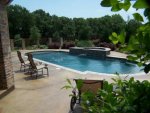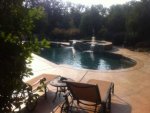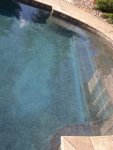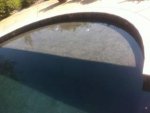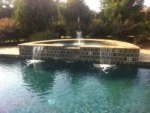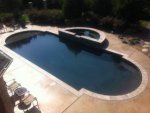This is a tough one! I built the pool myself and admit the start up was not properly done, i.e., not brushed often enough during the first few weeks of curing.
The pool is 5 years old and now looks better than ever with the exception of a few random patches of a milky gray coloring on the pool floor. Previously, this milky gray coloring was widespread over 100% of the pool. I recently performed a no drain acid wash for 4 days in which I shut the system down, lowered the PH to 4.0 and the total alkalinity to zero. The pool was brushed religiously 6 or more times a day. Now, 80% of the pool is in perfect condition, except there is still about 20% coverage of the off-white coloring. These few remaining patches are very stubborn!
I have now added a combination of Scaletec & Beautec in hopes of fixing the remaining gray patches. The plaster is Stonescapes Tahoe Blue, and now is a very dark color...what I would call a midnight blue. And the water is absolutely sparkling crystal clear!
The water has been always near perfect in chemical composition, and the CH runs between 250 - 280.
I was hoping to avoid doing a total drain and acid wash due to the cost which would run $675 including the cost to refill the pool, plus the additional cost of chemicals.
I actually think this is leftover plaster dust that was not brushed and eliminated during the startup, but someone else stated he thought it was scale.
Any suggestions? And thank you in advance for your input!
The pool is 5 years old and now looks better than ever with the exception of a few random patches of a milky gray coloring on the pool floor. Previously, this milky gray coloring was widespread over 100% of the pool. I recently performed a no drain acid wash for 4 days in which I shut the system down, lowered the PH to 4.0 and the total alkalinity to zero. The pool was brushed religiously 6 or more times a day. Now, 80% of the pool is in perfect condition, except there is still about 20% coverage of the off-white coloring. These few remaining patches are very stubborn!
I have now added a combination of Scaletec & Beautec in hopes of fixing the remaining gray patches. The plaster is Stonescapes Tahoe Blue, and now is a very dark color...what I would call a midnight blue. And the water is absolutely sparkling crystal clear!
The water has been always near perfect in chemical composition, and the CH runs between 250 - 280.
I was hoping to avoid doing a total drain and acid wash due to the cost which would run $675 including the cost to refill the pool, plus the additional cost of chemicals.
I actually think this is leftover plaster dust that was not brushed and eliminated during the startup, but someone else stated he thought it was scale.
Any suggestions? And thank you in advance for your input!


